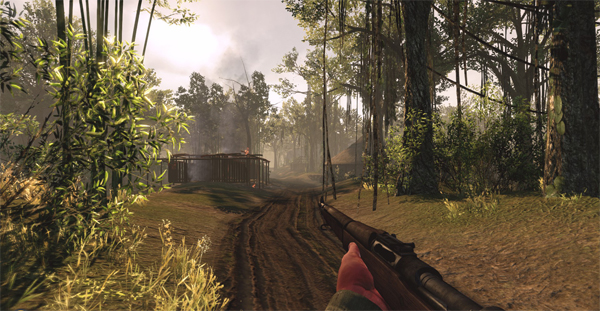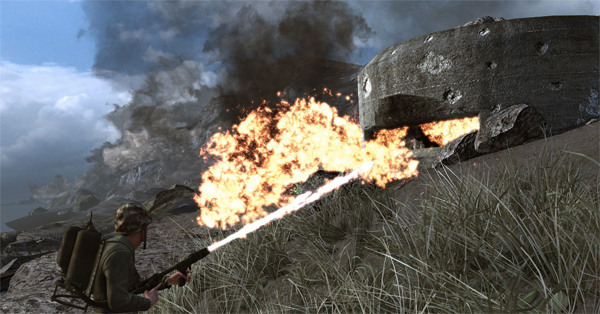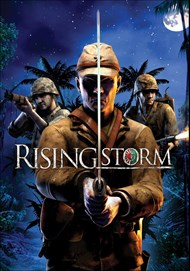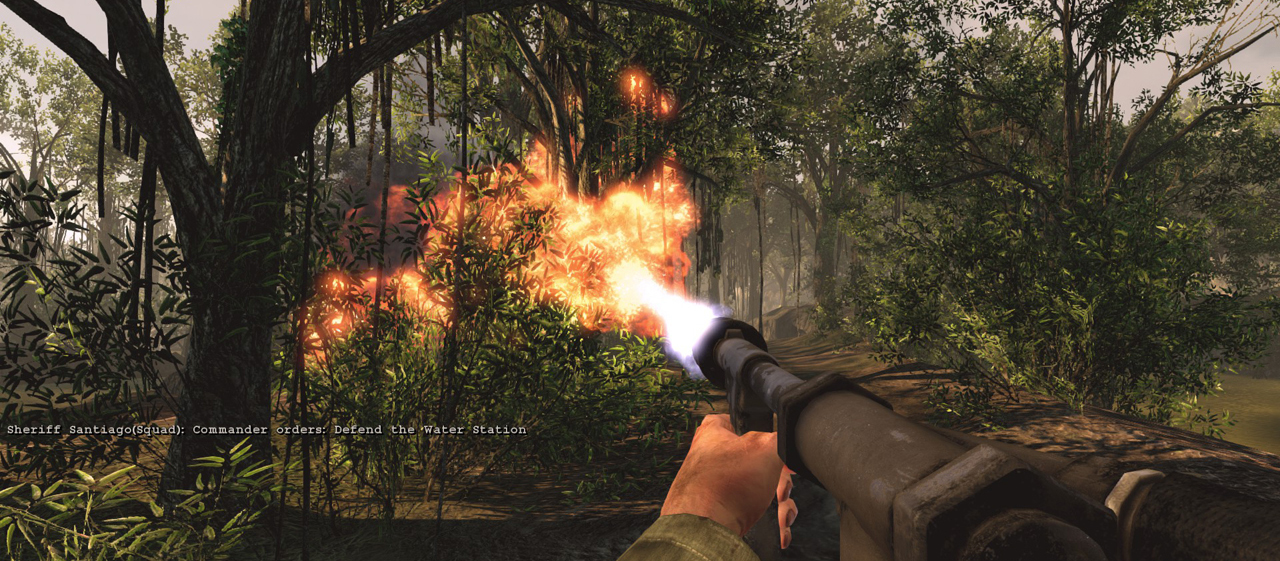Rising Storm doesn’t hold the war-torn hands of its players. Most competitive first person shooters fret over fairness and accessibility, placing each team an equal distance from a map’s center and providing boringly equivalent weapons at the expense of variety. They also elicit a sense of empowerment – Halo 4 provides tools necessary to run, jump, cloak, and shield your way out of any predicament – but Rising Storm focuses instead on vulnerability, and it couldn’t care less about appearing a little lopsided. The map Iwo Jima, for instance, has players charge uphill with little cover toward heavily armed bunkers. You are but one reinforcement, soon to be replaced by another.
A standalone multiplayer-only expansion of the two-year-old FPS Red Orchestra 2, Rising Storm eschews the general accessibility of today’s preeminent shooters, as did its predecessor. Modders-turned-development-studio Tripwire Interactive has built a game that requires mechanical mastery, tactical wit, and teamwork –- not twitch reflexes. Say you need to reach and destroy the nearest objective. You spawn, run forward, crouch-run through a trench, and are shot
. Dark red swallows your screen. You die. You wait ten seconds, noticing that despite your death, your team has inched forward. You respawn, run to the right, and enter the construct you must destroy. Swords drawn, four Japanese soldiers charge you, the reinforcement, and cut you down in a coordinated Banzai charge. You wait, respawn, repeat.
Enjoying Rising Storm requires patient persistence. Another scenario, following the last: You spawn, run left to cleverly avoid Objective A’s katana-wielding defenders (perhaps you’re just terrified of them), and maneuver into an enemy bunker. You panic as an enemy turns and discovers you. You panic. You spray your flamethrower erratically and fill the bunker with flames. You toast five Japanese and yourself. It’s a high-point that counters your previous lows –- you spawn, run forward, repeat.
My anecdote, however, describes only one of many exciting perspectives. A player’s most important decision in Rising Storm is to align with either the Axis or Allies. Americans attack and Japanese defend in objective gametypes, and the asymmetrical maps are designed accordingly, so one’s choice determines the landscape on which they will play. The opposing forces also features unique player roles that fundamentally alter the experience. American riflemen’s powerful semi-automatic rifles prove advantageous over the bolt-action variety of the Japanese. Japanese soldiers, however, can set booby traps and initiate a Banzai charge, an enemy-suppressing melee attack that increases damage as more soldiers participate. The American flamethrower role thrills most consistently. It’s high-risk and high-reward, as its limited range forces players to either evade enemy gunfire across wide-open terrain or flank. Even if it takes three or four attempts to succeed, clearing out an enemy bunker is downright euphoric, and sometimes eliminates ten players at once. All of these specialties, mind you, engage at once in conflicts of up to 64 players, and Tripwire somehow made the amalgam of play options feel authentic and balanced.
 This balance therefore makes all kills feel deserved, save those on computer-controlled bots. While getting acquainted with Rising Storm’s cover and long-range bullet drop systems, bots are welcome target practice. After that, beyond being used sacrificially, they are tactically useless. “Bots,” explained a teammate, “are really just the personification of Milk Duds.” This is unfortunate, because Rising Storm is predominantly tactically-minded. I love how a death count is absent on the in-game leaderboard to encourage players to keep fighting forward despite deaths. Further, a vocal and tactical squad leader –- one who can use artillery strikes, issue commands, and direct bots –- helps matches feel more strategic and less like a crapshoot. These emphases make it easy to forget about a K:D ratio and focus on the tactical play that makes Rising Storm special.
This balance therefore makes all kills feel deserved, save those on computer-controlled bots. While getting acquainted with Rising Storm’s cover and long-range bullet drop systems, bots are welcome target practice. After that, beyond being used sacrificially, they are tactically useless. “Bots,” explained a teammate, “are really just the personification of Milk Duds.” This is unfortunate, because Rising Storm is predominantly tactically-minded. I love how a death count is absent on the in-game leaderboard to encourage players to keep fighting forward despite deaths. Further, a vocal and tactical squad leader –- one who can use artillery strikes, issue commands, and direct bots –- helps matches feel more strategic and less like a crapshoot. These emphases make it easy to forget about a K:D ratio and focus on the tactical play that makes Rising Storm special.
A tricky cover system overlaying the usual FPS controls, which allows players to peek around cover, blind fire, shield themselves, and hide, makes efficient movement and defense tough skills to acquire. Exacerbating a system that already doesn’t cooperate with intentions, players activate cover with the same control used for healing. Like most mechanical quirks, this will matter less after time and with practice, but will undoubtedly confuse and turn off newcomers that find themselves bandaging nonexistent wounds while trying to take cover. A positive experience therefore depends on a player’s patience for learning, tolerating, and, to some extent, mastering Rising Storm’s in-depth mechanics. Rising Storm will satisfy players who don’t mind perfecting the craft of in-cover movement –- in other words, players who aren’t seeking instant gratification. Otherwise, this romp through the Pacific Theater will bore, frustrate, and crush their spirits.
 Rising Storm’s respawn system revolves around the idea that respawned players are reinforcements. This is one of Rising Storm’s many simple explanations for typical FPS systems like spawning and spawn-switching. In objective gametypes, the Allies and Axis don’t switch map sides between rounds because that’s not how it worked in Iwo Jima; Americans stormed the bunker-laden terrain uphill. Rising Storm places you in Iwo Jima, but the battle’s outcome relies on in-game performance. In this sense, Rising Storm strives for realism. Tripwire definitely understood that particle effects and lens flares aren’t the only metrics by which realism is measured.
Rising Storm’s respawn system revolves around the idea that respawned players are reinforcements. This is one of Rising Storm’s many simple explanations for typical FPS systems like spawning and spawn-switching. In objective gametypes, the Allies and Axis don’t switch map sides between rounds because that’s not how it worked in Iwo Jima; Americans stormed the bunker-laden terrain uphill. Rising Storm places you in Iwo Jima, but the battle’s outcome relies on in-game performance. In this sense, Rising Storm strives for realism. Tripwire definitely understood that particle effects and lens flares aren’t the only metrics by which realism is measured.
Rising Storm’s six huge, asymmetrical maps provide a variety of environments for players of all types to thrive. Guadalcanal is a nighttime jungle perfect for booby traps and Banzai charges. Peleliu, a deserted, sun-baked military complex, sets up long-range firefights in the open space between destroyed hangars and other dilapidated buildings. Like all shooters, map knowledge is key to success, but given their size it’s hard to quickly attain that knowledge. I died often in a search for an advantageous piece of cover, but after five or so deaths I found a spot that led to five quick kills. Another high. The trick was finding my way back after another inevitable death. Iwo Jima, a brilliant recreation of the famous American uphill siege, is my favorite map. Here, especially with the flamethrower, the risky maneuvering out of open space and into enemy bunkers perfectly encapsulates the game’s clashing themes of vulnerability and empowerment.
Tripwire has injected this sense of vulnerability into every facet of Rising Storm. This is its greatest strength. But how it encourages players to empower themselves by overcoming those vulnerabilities is a close second. For players who aren’t seeking a guiding hand to lead them from vulnerable to empowered, Rising Storm is an essential WWII shooter.



















